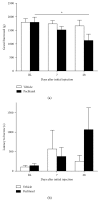Evoked and Ongoing Pain-Like Behaviours in a Rat Model of Paclitaxel-Induced Peripheral Neuropathy
- PMID: 29973969
- PMCID: PMC6008701
- DOI: 10.1155/2018/8217613
Evoked and Ongoing Pain-Like Behaviours in a Rat Model of Paclitaxel-Induced Peripheral Neuropathy
Abstract
Paclitaxel-induced neuropathic pain is a major dose-limiting side effect of paclitaxel therapy. This study characterises a variety of rat behavioural responses induced by intermittent administration of clinically formulated paclitaxel. 2 mg/kg paclitaxel or equivalent vehicle was administered intraperitoneally on days 0, 2, 4, and 6 to adult male Sprague-Dawley rats. Evoked pain-like behaviours were assessed with von Frey filaments, acetone, or radiant heat application to plantar hind paws to ascertain mechanical, cold, or heat sensitivity, respectively. Motor coordination was evaluated using an accelerating RotaRod apparatus. Ongoing pain-like behaviour was assessed via spontaneous burrowing and nocturnal wheel running. Mechanical and cold hypersensitivity developed after a delayed onset, peaked approximately on day 28, and persisted for several months. Heat sensitivity and motor coordination were unaltered in paclitaxel-treated rats. Spontaneous burrowing behaviour and nocturnal wheel running were significantly impaired on day 28, but not on day 7, indicating ongoing pain-like behaviour, rather than acute drug toxicity. This study comprehensively characterises a rat model of paclitaxel-induced peripheral neuropathy, providing the first evidence for ongoing pain-like behaviour, which occurs in parallel with maximal mechanical/cold hypersensitivity. We hope that this new data improve the face validity of rat models to better reflect patient-reported pain symptoms, aiding translation of new treatments to the clinic.
Figures







Similar articles
-
The effects of opioid receptor antagonists on electroacupuncture-produced anti-allodynia/hyperalgesia in rats with paclitaxel-evoked peripheral neuropathy.Brain Res. 2011 Sep 26;1414:58-65. doi: 10.1016/j.brainres.2011.08.004. Epub 2011 Aug 7. Brain Res. 2011. PMID: 21872220 Free PMC article.
-
Beneficial effects of Gelsemium-based treatment against paclitaxel-induced painful symptoms.Neurol Sci. 2018 Dec;39(12):2183-2196. doi: 10.1007/s10072-018-3575-z. Epub 2018 Sep 24. Neurol Sci. 2018. PMID: 30251080
-
Pharmacological Modulation of the Mitochondrial Electron Transport Chain in Paclitaxel-Induced Painful Peripheral Neuropathy.J Pain. 2015 Oct;16(10):981-94. doi: 10.1016/j.jpain.2015.06.008. Epub 2015 Jul 2. J Pain. 2015. PMID: 26142652 Free PMC article. Clinical Trial.
-
Prophylactic cannabinoid administration blocks the development of paclitaxel-induced neuropathic nociception during analgesic treatment and following cessation of drug delivery.Mol Pain. 2014 Apr 18;10:27. doi: 10.1186/1744-8069-10-27. Mol Pain. 2014. PMID: 24742127 Free PMC article.
-
Chronic Sciatic Neuropathy in Rat Reduces Voluntary Wheel-Running Activity With Concurrent Chronic Mechanical Allodynia.Anesth Analg. 2017 Jan;124(1):346-355. doi: 10.1213/ANE.0000000000001662. Anesth Analg. 2017. PMID: 27782944 Free PMC article.
Cited by
-
Monoclonal Antibodies for Chronic Pain Treatment: Present and Future.Int J Mol Sci. 2021 Sep 25;22(19):10325. doi: 10.3390/ijms221910325. Int J Mol Sci. 2021. PMID: 34638667 Free PMC article. Review.
-
Cancer-induced Bone Pain Impairs Burrowing Behaviour in Mouse and Rat.In Vivo. 2019 Jul-Aug;33(4):1125-1132. doi: 10.21873/invivo.11582. In Vivo. 2019. PMID: 31280201 Free PMC article.
-
Effects of vitamin D administration on nociception and spinal cord pro-oxidant and antioxidant markers in a rat model of neuropathic pain.Braz J Med Biol Res. 2021 Aug 6;54(10):e11207. doi: 10.1590/1414-431X2021e11207. eCollection 2021. Braz J Med Biol Res. 2021. PMID: 34378677 Free PMC article.
-
Systematic review and meta-analysis of studies in which burrowing behaviour was assessed in rodent models of disease-associated persistent pain.Pain. 2022 Nov 1;163(11):2076-2102. doi: 10.1097/j.pain.0000000000002632. Epub 2022 Mar 29. Pain. 2022. PMID: 35353780 Free PMC article.
-
Modulation of Pathological Pain by Epidermal Growth Factor Receptor.Front Pharmacol. 2021 May 12;12:642820. doi: 10.3389/fphar.2021.642820. eCollection 2021. Front Pharmacol. 2021. PMID: 34054523 Free PMC article. Review.
References
-
- Augusto C., Pietro M., Cinzia M., et al. Peripheral neuropathy due to paclitaxel: study of the temporal relationships between the therapeutic schedule and the clinical quantitative score (QST) and comparison with neurophysiological findings. Journal of Neuro-Oncology. 2008;86(1):89–99. doi: 10.1007/s11060-007-9438-8. - DOI - PubMed
Publication types
MeSH terms
Substances
Grants and funding
LinkOut - more resources
Full Text Sources
Other Literature Sources
Medical

